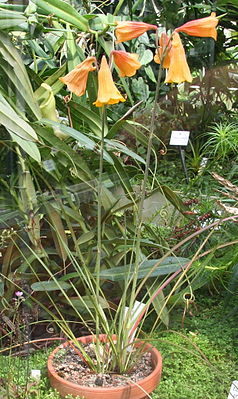Blandfordia
| Blandfordia | ||||||||||||
|---|---|---|---|---|---|---|---|---|---|---|---|---|

Blandfordia grandiflora |
||||||||||||
| Systematics | ||||||||||||
|
||||||||||||
| Scientific name of the family | ||||||||||||
| Blandfordiaceae | ||||||||||||
| R.Dahlgren & H.Clifford | ||||||||||||
| Scientific name of the genus | ||||||||||||
| Blandfordia | ||||||||||||
| Sm. |
Blandfordia is a genus of plants and forms only the family Blandfordiaceae within the order of the asparagus-like (Asparagales).
features
The species are perennial, herbaceous plants with a bulbous, short rhizome . Fibrous roots sit on this. The leaves are up to one meter long, alternate and stand in two lines (distich). They are seated and surround the rhizome like a sheath, creating an onion-like structure. The leaf blades are linear with numerous parallel nerves. The stomata are anomocytic and are only located on the underside of the leaf (abaxial).
The roots have xylem vessels with simple or step-shaped openings, the trunk and leaves only tracheids .
The inflorescences are terminal clusters with a height of up to 1.5 meters and up to 20 flowers . The flowers are hermaphroditic. The flower stalk arises in the axilla of small bracts and has two bracts . The six bracts ( tepals ) are fused into a bell-shaped tube with six broad bell lobes. The color is red-yellow, orange or yellow.
The stamens of the six stamens are fused to a third to half with the corolla tube. The latrorsen, dorsifixen stamens have two counters with two spore sacks each, which open with slits. The pollen is ellipsoidal, sulcat with a granular exine. The diameter is 28 to 50 micrometers.
The upper pistil consists of three fused carpels. There is a stylus with a three-furrowed scar . The anatropic, bitegmic and crassinucellate ovules are in each of the three ovary compartments in two rows on the central angular placenta .
The fruit is a septicidal capsule . The seeds are brown and covered with hair-like papillae. The abundant endosperm is starch-free.
Starch is produced in the root cortex and leaf sheaths; the leaf blades are starch-free. There have also been chelidonic acid , flavone C-glycosides and cyanidin detected glycosides.
The basic chromosome number is x = 17 and x = 27.
Flower ecology
The flowers are mostly of birds from the family of honeyeater (Meliphagidae) pollinated ( ornithophily ). However, Blandfordia grandiflora in the Blue Mountains is self-pollinating while the lowland populations are self-sterile.
The flower formation also depends on the nutrient content of the soil. In the five years after a fire, most plants bloom once or twice, and not longer after a fire.
distribution

The genus is endemic to Australia . It occurs here only in the southeast of the mainland and on Tasmania in the subtropical and temperate areas. They occur mainly in the heather, especially in seasonally flooded locations. The main distribution is in coastal areas below 1000 m. There are some isolated populations in the Blue Mountains.
Systematics
Within the order Asparagales , the Blandfordiaceae form a clade together with the Boryaceae , Lanariaceae , Asteliaceae and Hypoxidaceae . The family consists of the only genus Blandfordia Sm. With four species:
- Blandfordia cunninghamii Lindl. : It occurs in New South Wales.
- Blandfordia grandiflora R.Br. : It occurs from southeast Queensland to northeast New South Wales.
- Blandfordia nobilis Sm . : It occurs in eastern New South Wales.
- Christmas bell ( Blandfordia punicea (Labill.) Sweet ): It occurs in Tasmania.
Botanical history
The genus was first described by James Edward Smith in 1804 based on the Blandfordia nobilis and named in honor of George Spencer Churchill, Marquess of Blandford (1766-1840). The other three species of the genus were also known by 1845.
In the 19th century the genus was a popular ornamental plant in England.
swell
The article is based on the following documents:
- HT Clifford, JG Conran: Blandfordiaceae . In: Klaus Kubitzki (Ed.): The Families and Genera of Vascular Plants . tape 3 . Springer, Berlin 1998, ISBN 978-3-540-64060-8 , pp. 148-150 .
- Tony Cavanagh: Blandfordia in History . In: Australian Plants . March 1996 ( online [accessed June 11, 2014]).
Individual evidence
- ↑ a b c d Rafaël Govaerts (Ed.): Blandfordia. In: World Checklist of Selected Plant Families (WCSP) - The Board of Trustees of the Royal Botanic Gardens, Kew . Retrieved July 22, 2018.
- ↑ Lotte Burkhardt: Directory of eponymous plant names . Extended Edition. Botanic Garden and Botanical Museum Berlin, Free University Berlin Berlin 2018. [1]

